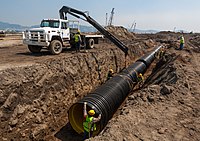
Photo from wikipedia
OBJECTIVE Nasoseptal flap reconstruction is a widely accepted method for reducing cerebrospinal fluid (CSF) leakage after endoscopic transnasal surgeries (ETSs). However, this method is associated with nasal complications and is… Click to show full abstract
OBJECTIVE Nasoseptal flap reconstruction is a widely accepted method for reducing cerebrospinal fluid (CSF) leakage after endoscopic transnasal surgeries (ETSs). However, this method is associated with nasal complications and is difficult to apply repeatedly in recurrent cases. Therefore, alternative methods are needed. METHODS Layers of autologous fascia lata were placed on the inside and outside of the dural defect to sufficiently cover it, and the grafts were compressed with an inflated balloon. A lumbar drainage system with a pressure-control valve was used for 72 hours postoperatively. We retrospectively analyzed data on patients with skull base lesions showing intracranial extensions that required wide opening of the ventral dura in ETS. Fifty cases (47 skull base tumors and 3 others) were included, 28 of which were recurrent cases. RESULTS In 21 cases (42%), the nasal septum was not intact because of the previous ETS. Seventeen patients (34%) had a history of radiotherapy and 9 (18%) had undergone multisession radiotherapies. None of the 50 patients required additional surgery for postoperative CSF rhinorrhea, and 2 had intermittent CSF leakage that resolved with prolonged lumbar drainage placement for a week. Previous multisession radiotherapy was the only significant risk factor for the need of prolonged drainage (P = 0.029). CONCLUSIONS The multilayer closure method with a pressure-control spinal drainage system is a simple, safe, and effective method for preventing postoperative CSF leakage, which can be readily applied to dural defects in any parts of the skull base regions and in patients with various conditions.
Journal Title: World neurosurgery
Year Published: 2018
Link to full text (if available)
Share on Social Media: Sign Up to like & get
recommendations!